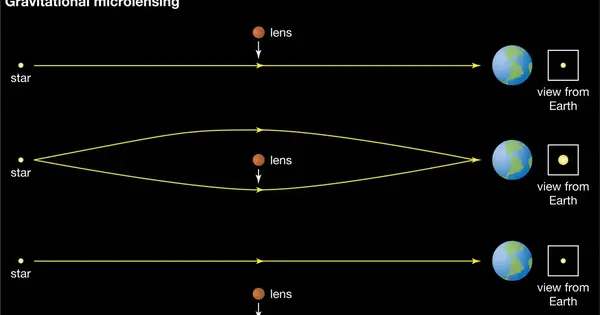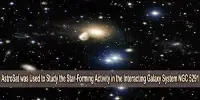Einstein’s theory of general relativity predicts gravitational microlensing. Because of the gravitational lens effect, it is an astronomical phenomenon. It happens when the gravitational field of a massive object, such as a star or planet, acts like a lens, magnifying light from a more distant background object, such as another star. It can detect objects ranging in mass from a planet’s to a star’s, regardless of the light they emit.
Astronomers typically can detect only bright objects that emit a lot of light (stars) or large objects that block out the background light (clouds of gas and dust). These objects constitute only a small proportion of a galaxy’s total mass. Microlensing allows the study of objects that emit little or no light. This effect is a consequence of the bending of light around massive objects due to gravity.
Key points about gravitational microlensing:
- Massive Object as a Lens: The lensing object (for example, a star or planet) must have enough mass to bend light from the background source. The gravitational lensing effect is stronger the larger the object.
- Alignment: For microlensing to occur, the lensing object, the background source, and the observer (Earth) must be nearly perfectly aligned. This alignment is extremely rare in the vastness of space.
- Light Curves: The magnification of the brightness of the background source typically produces a distinct light curve. The light curve is a time-series plot of the observed brightness, displaying a symmetric increase and decrease in brightness as the lensing object moves in front of the background source.
- Detecting Exoplanets: Gravitational microlensing has been used as a method to detect exoplanets. If a planet orbits the lensing star, it can cause additional variations in the light curve. These deviations provide information about the presence and properties of the planet.
- MACHOs and WIMPs: Gravitational microlensing has been proposed as a way to detect dark matter in the form of Massive Astrophysical Compact Halo Objects (MACHOs) or Weakly Interacting Massive Particles (WIMPs). The idea is that dark matter objects could act as lenses and produce observable microlensing events.
When a distant star or quasar is sufficiently aligned with a massive compact foreground object, the bending of light due to its gravitational field, as discussed by Albert Einstein in 1915, results in two distorted images, resulting in an observable magnification. The time scale of the transient brightening is determined by the mass of the foreground object as well as the relative proper motion between the background’source’ and the foreground ‘lens’ object.
The basic idea is that the gravitational field of the foreground object, acting like a lens, bends and focuses the light from the background object, causing a temporary increase in brightness that can be seen from Earth. This effect is typically small and brief, lasting weeks to months.
















